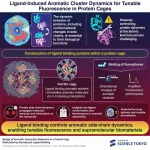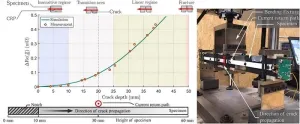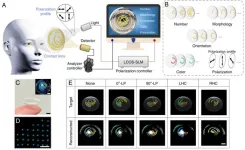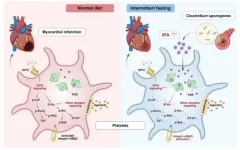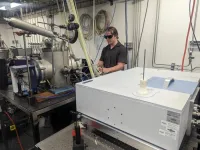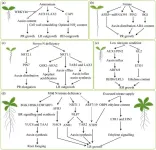(Press-News.org)
Novel protein cage system can control and visualize orientational changes in aromatic side chains upon ligand binding, as reported by researchers at Institute of Science Tokyo. By inducing coordinated molecular changes, this approach enables precise control over protein dynamics while also enhancing fluorescence properties. Their breakthrough could lead to applications in biomolecular robotics, drug delivery, and advancing the development of responsive biomaterials.
The dynamic nature of proteins—their ability to bend, fold, and change shape in response to their environment—underlies most aspects of cellular function. Conformational changes in proteins, which occur at the nanoscale, are fundamental to processes ranging from enzyme catalysis and chemical signaling to cell division and differentiation.
Aromatic interactions are particularly important in protein dynamics, playing roles in protein folding, molecular recognition, and the stabilization of protein complexes. However, designing systems that can control protein dynamics at an atomic level, such as the orientation of specific aromatic side chains, has remained a significant challenge in applied chemistry and biomaterials. In turn, this has limited our ability to develop sophisticated protein-based technologies.
Fortunately, a research team led by Professor Takafumi Ueno from Institute of Science Tokyo(Science Tokyo), Japan, has been working on innovative solutions towards this goal. In their latest study, published in Advanced Science on 20 February 2025, the researchers designed a protein cage system that can control and visualize the movement of multiple aromatic side chains through the strategic binding of fluorescent ligands. Their approach represents a significant breakthrough in protein engineering, offering unprecedented control over certain protein dynamics.
The team engineered special “pockets” within a protein cage structure called ferritin, surrounding these pockets with carefully arranged clusters of aromatic amino acids. When specific fluorescent ligands bind to these pockets, they trigger what could be described as a molecular domino effect—a coordinated series of changes in the orientation of the surrounding aromatic side chains.
Through detailed X-ray crystallography analysis, the researchers demonstrated that different ligand structures could produce different orientational changes in the aromatic side chain. The team systematically investigated this phenomenon by designing variants with different numbers and types of phenylalanine group substitutions. This approach allowed them to fine-tune the system’s response to different molecular binding events. Interestingly, when certain fluorescent molecules were isolated within these aromatic pockets, they also exhibited markedly enhanced fluorescence properties, including improved quantum yield and longer fluorescence lifetime. “Together, these findings provide an understanding of the unique molecular behavior and fluorescence properties of ligands due to the assembly of aromatic residues, and a guideline for developing dynamically controlled supramolecular biomaterials,” explains Ueno.
The success of this approach hinged on the team’s innovative strategy of using ligand binding as a driving force to induce and propagate changes in aromatic side chains. Manipulating protein side-chain dynamics could be used to propagate molecular behavior and information across nanoscale distances, which could prove useful in a number of ways. “The expected applications of this technology include the creation of biomolecular robots responsive to external stimuli and the use of such protein systems for drug delivery, especially for compounds with poor solubility in water,” notes Ueno. The system’s ability to enhance fluorescence properties while providing controlled molecular mohttps://www.isct.ac.jp/envement could also prove particularly valuable for biosensors.
Overall, this study opens new possibilities in medicine, biotechnology, and materials science, paving the way to responsive biomaterials that can be precisely controlled at the molecular level.
About Institute of Science Tokyo (Science Tokyo)
Institute of Science Tokyo (Science Tokyo) was established on October 1, 2024, following the merger between Tokyo Medical and Dental University (TMDU) and Tokyo Institute of Technology (Tokyo Tech), with the mission of “Advancing science and human well-being to create value for and with society.”
https://www.isct.ac.jp/en
END
In our paper “Experimental and Numerical Analysis of the Potential Drop Method for Defects Caused by Dynamic Loads”, we investigate how the electrodynamic proximity effect can be utilized to enhance the defect sensitivity of PDM in SHM applications by proper arrangement of the measurement setup. We showed how eddy current effects present in our PDM setup can be modeled analytically and numerically. Lock-in technique and the application of the skin effect allow high- resolution impedance ...
Chiral-structural-color materials produce color through microscopic structures that interact with light rather than through pigmentation or dyes. Some beetle exoskeletons, avian feathers, butterfly wings, and marine organisms feature these structures naturally, producing iridescent or polarization-dependent colors. Over the last 10–15 years, scientists have made progress in developing artificial chiral-structural-color materials.
Recently, Chinese researchers have made a breakthrough in the field by discovering that microdomes made from common polymers exhibit tunable chiral structural colors with broad-spectrum capabilities and multiple ...
Cardiovascular diseases remain a leading cause of death worldwide, with platelet hyperactivity and subsequent thrombosis playing a pivotal role in these conditions. While intermittent fasting has long been recognized for its metabolic benefits, including improvements in metabolic diseases, weight loss, and even lifespan extension, its effect on platelet activation and thrombosis formation remains less understood.
A recent study by Professor Junbo Ge team at Fudan University unveiled a novel mechanism by which intermittent fasting can significantly reduce the risk of platelet hyperactivity and thrombosis. That is, intermittent fasting elevates levels of the metabolite ...
Curtin University researchers have developed a new technique to make glass water-repellent, a feature that could improve safety in vehicles, reduce cleaning costs for buildings and enhance filtration systems.
The research, published in the prestigious journal Advanced Functional Materials, shows how an innovative and non-toxic process using ultrasonic sound waves can alter the surface of glass, making it either hydrophobic (water resistant) or electrically charged.
Lead researcher Associate Professor Nadim Darwish, an ARC Future Fellow at Curtin’s ...
A team of scientists at UNSW has discovered that some of the most important new refrigerants break down, in part, into persistent greenhouse gas pollutants, including compounds that have been banned internationally. Refrigerants are chemicals that turn from a liquid to a gas – and vice-versa – and transfer heat in the process, that are used for refrigeration and indoor heating and cooling. The chemicals are also used as aerosol propellants, fire retardants and in the manufacture of foamed plastics.
Hydrofluoroolefins (HFOs), which react rapidly in the lower atmosphere, have emerged as the lead synthetic chemical for refrigerants, and are considered a more environmentally friendly ...
In soil, nitrogen (N), an essential macronutrient for plant growth, exhibits significant spatial heterogeneity. This necessitates plants to grapple with a complex array of environmental conditions in their quest for N sustenance. Roots, as the pivotal organs in N acquisition, manifest a remarkable morphological plasticity, including variations in the length and density of primary roots, lateral roots, and root hairs, in response to the form and content of available N, which is termed N-dependent root system architecture (RSA). For cultivated crops, the ...
A research team at POSTECH (Pohang University of Science and Technology) has successfully developed a super-photostable organic dye after two years of dedicated research—demonstrating perseverance akin to that of Marie Curie, who painstakingly extracted just 0.1 grams of radium from eight tons of ore to earn her Nobel Prize.
Single-molecule imaging, a technique that uses fluorescent markers to track proteins with precision, plays a crucial role in cell biology, biochemistry, molecular biology, and drug discovery. However, conventional organic ...
Benefits of the New Method:
Enhanced Efficiency: The filter membrane allows air exchange while preventing bacterial contamination, eliminating the need for frequent cap opening and reducing the risk of errors.
Improved Reproducibility: The standardized protocol ensures consistent results, with a 100% success rate in generating germ-free flies compared to the previous 70%–80% rate.
Streamlined Process: This method simplifies the entire process, making it more accessible to researchers and allowing for larger-scale experiments.
Implications for Research:
This advancement opens doors for deeper exploration of the intricate dance between hosts ...
What if a critical piece of the puzzle of brain aging has been hiding in plain sight? While neuroscience has long focused on proteins and DNA, a team of Stanford researchers dared to shift their gaze to sugars – specifically the complex sugar chains that cover all our cells like chain mail.
Their investigation revealed how changes in this sugary armor on the brain’s frontline cells could be key to understanding cognitive decline and diseases like Alzheimer’s.
“This is like landing on a new planet,” ...
ITHACA, N.Y. – Leveraging national surveys, big data, and machine learning, Cornell University researchers have developed a new approach to mapping poverty that could help policymakers and NGOs better identify the neediest populations in poor countries and allocate resources more effectively.
To eliminate extreme poverty, defined as surviving on less than $2.15 per person per day, governments and development and humanitarian agencies need to know how many people live under that threshold, and where. Yet that information ...
